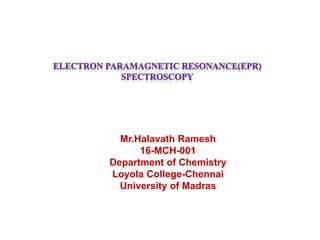
Electron paramagnetic resonance(epr) spectroscopy
- 1. Mr.Halavath Ramesh 16-MCH-001 Department of Chemistry Loyola College-Chennai University of Madras
- 2. Electron Para magnetic resonance(EPR) or Electron Spin Resonance(ESR) Spectroscopy is a method for studying materials with unpaired electrons.EPR spectroscopy is particularly useful for studying metal complexes or organic radicals. The basic concepts of EPR are analogous to those of nuclear magnetic resonances (NMR),But it is electron spin that are excited instead of the spins of atomic nuclei. It is a Non-destructive technique. It is a branch of absorption spectroscopy in which radiation having frequency in microwave region. This is a technique for detecting paramagnetism. Zeeman Effect: The effect of splitting of a spectral line into several components in the presences of a static magnetic field. ESR Phenomenon is shown by * Atoms having odd number of electrons. * Ions having partly filled inner electron shells. * Free radicals having unpaired electrons. Application for species with one or more unpaired electrons. Free Radicals Transition metal complexes. Useful unstable paramagnetic compounds generated in situ. * Electrochemical Oxidation or reduction. Principle 1.The unpaired electrons are excited to a high energy state under the magnetic field by the absorption of microwave radiations.
- 3. 2. The excited electron changes its direction of spin and relaxes in to the ground state by emitting its energy. 3.The transition between two different energy levels takes places by absorbing a quantum of radiation of frequency in the microwave region. 4. Microwave absorption is measured as a function of the magnetic field by ESR spectroscopy. 5.In ESR the energy levels are produced by the interaction of magnetic moment of an unpaired electron in a molecules with an applied magnetic field. 6. The ESR spectrum results in due to the transitions between these energy levels by absorbing radiations of microwave frequency. Instrumentation 1. Source. 2. sample cavity. 3. Magnet System. 4. crystal Detector. 5. Auto- Amplifier and phase sensitive Detector 6. Oscilloscope. Applications 1. ESR Spectroscopy is one of the main methods used to study metallo proteins particularly those containing molybdenum ,copper ,iron etc. 2. Both copper and non-haem iron do not absorb radiation in visible and ultra violet range, posses ESR absorbance peak in one of their oxidation state. 3. Hence their appearance and dis appearances of their ESR signal are used to monitor their activity in multi enzyme system. 4. In metallo proteins the metal atom has characteristic number of ligands co ordinate to it in a definite geometrical arrangement. Studies using ESR have shown that their geometry is frequently distorted. 5. This techniques ESR has been extended by spin labeling.
- 4. Origin of an EPR Signal Every electron has a magnetic moment and spin quantum number S= ½ with magnetic components ms = +1/2 and ms= - ½. In the presences of an external magnetic field with strength B0 ,the electrons magnetic moment alignment having a specific energy due to the Zeeman effect. Where, ge is the electron so-called g-factor.ge= 2.0023 for the free electron μB is the Bohr magnetron.
- 5. Therefore the separation between the lower and the upper state is ΔЀ= ge µB B0 for unpaired free electrons. An unpaired electron can move between the two energy levels by either absorbing or emitting a photon of energy hυ such that resonances condition hυ= ΔE, is obeyed .This leads to the fundamental equation of EPR Spectroscopy. hυ= geμB Bο
- 13. EPR Spectroscopy If the compound containing unpaired electrons, such as an organic molecule with a free radicals, is exposed to an external magnetic field, the energy levels accessible to the unpaired electronic spin are split by that field.Since an electron features a spin of s= ½, two energy levels are possible; Ms= -1/2,the low energy state, and Ms=+1/2 ,the high energy state. As the field strength is increased ,the energy difference between these two states increase linearly. This phenomenon is exploited in EPR spectroscopy. Where the compound placed inside the magnetic field is exposed to constant frequency microwave radiation. At magnetic field strength corresponding to an energy difference resonant with the energy of the applied microwave frequency ,electrons are promoted from the low energy to the high energy state. These transitions are absorbed as the absorption of a portion of the micro wave intensity. Since these absorptions are fairly broad, an accurate measure of the spacing between the peaks is usually obtained by examining the first derivative spectrum. Therefore EPR spectra are conventionally recorded as the rate of change of absorption versus field strength. EPR is a powerful and sensitive technique for the study of macromolecular structure and function because EPR signals are generated only by unpaired electrons.
- 21. New words Hygroscope: Hygroscope is the phenomenon of attracting and holding water molecules from the surrounding environment which is normal or room temperature. Hyperfine splitting: In atomic physics hyperfine structure refers to small shifts and splitting in the energy levels of atoms, Molecules, and ions due to interaction between the state of the nucleus and the state of the electron clouds. What is G Factor in ESR? In atomic physics, the electron spin g-factor is often defined as the absolute values or negative of ge. The z-Component of the magnetic moment then becomes. The value gs is roughly equal to 2.002319 and is known to extraordinary precision.